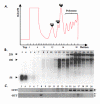Genomic analysis of the secretion stress response in the enzyme-producing cell factory Aspergillus niger
- PMID: 17561995
- PMCID: PMC1894978
- DOI: 10.1186/1471-2164-8-158
Genomic analysis of the secretion stress response in the enzyme-producing cell factory Aspergillus niger
Abstract
Background: Filamentous fungi such as Aspergillus niger have a high capacity secretory system and are therefore widely exploited for the industrial production of native and heterologous proteins. However, in most cases the yields of non-fungal proteins are significantly lower than those obtained for fungal proteins. One well-studied bottleneck appears to be the result of mis-folding of heterologous proteins in the ER during early stages of secretion, with related stress responses in the host, including the unfolded protein response (UPR). This study aims at uncovering transcriptional and translational responses occurring in A. niger exposed to secretion stress.
Results: A genome-wide transcriptional analysis of protein secretion-related stress responses was determined using Affymetrix DNA GeneChips and independent verification for selected genes. Endoplasmic reticulum (ER)-associated stress was induced either by chemical treatment of the wild-type cells with dithiothreitol (DTT) or tunicamycin, or by expressing a human protein, tissue plasminogen activator (t-PA). All of these treatments triggered the UPR, as shown by the expression levels of several well-known UPR target genes. The predicted proteins encoded by most of the up-regulated genes function as part of the secretory system including chaperones, foldases, glycosylation enzymes, vesicle transport proteins, and ER-associated degradation proteins. Several genes were down-regulated under stress conditions and these included several genes that encode secreted enzymes. Moreover, translational regulation under ER stress was investigated by polysomal fractionation. This analysis confirmed the post-transcriptional control of hacA expression and highlighted that differential translation also occurs during ER stress, in particular for some genes encoding secreted proteins or proteins involved in ribosomal biogenesis and assembly.
Conclusion: This is first genome-wide analysis of both transcriptional and translational events following protein secretion stress. Insight has been gained into the molecular basis of protein secretion and secretion-related stress in an effective protein-secreting fungus, and provides an opportunity to identify target genes for manipulation in strain improvement strategies.
Figures





References
-
- MacKenzie DA, Jeenes DJ, Archer DB. Filamentous fungi as expression systems for heterologous proteins. In: Kück U, editor. The Mycota II. New York , Springer; 2004. pp. 289–315.
-
- Archer DB, Peberdy JF. The molecular biology of secreted enzyme production by fungi. Crit Rev Biotechnol. 1997;17:273–306. - PubMed
Publication types
MeSH terms
Substances
Grants and funding
LinkOut - more resources
Full Text Sources
Other Literature Sources

